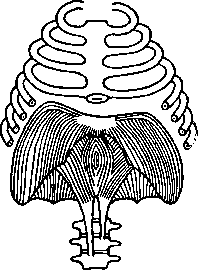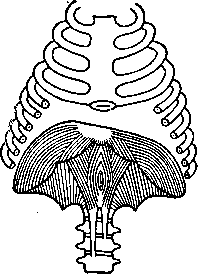Voice Training In Speech And Song - online tutorial
The Structure And Use Of The Vocal Organs, And The Means Of Securing Distinct Articulation.
| Share page | Visit Us On FB |
|
22 THE BREATHING APPARATUS. |
|||
|
If the protrusion of the front abdominal wall is prevented while the diaphragm flattens, the ribs are raised and are carried outwards, and both the lower part of the |
|||
|
|
|||
 |
 |
||
|
Fig. 14.—The Diaphragm at rest. Fig. 15.—The Diaphragm contracted
AND FLATTENED IN BREATHING FOR
Tendon in centre ; muscular fibres at Voice.
sides, back and front. Curved
higher on right side than on left The Tendon has scarcely moved, and the side. Diaphragm has moved more on the
left than on the right. It is lower and wider than when at rest.
The Diaphragm is very like an umbrella in shape, more widely open in Fig. 15 than in Fig. 14.
When the Diaphragm is contracted in breathing for voice the chest becomes longer, deeper, and wider. The lower ribs are raised and moved outwards, the lower part of the sternum is pushed forward, and the chest is increased in size from side to side and from before backwards. The lowering of the sides of the Diaphragm about one inch increases the diameter from above downwards. If the ribs are fixed as in abdominal breathing the Diaphragm descends much lower, usually about three inches. |
|||
|
chest and the upper part of the abdomen are increased in size from side to side and from before backwards (Fig. 15). These separate actions of the diaphragm materially affect the methods used in breathing. The first action is used in |
|||